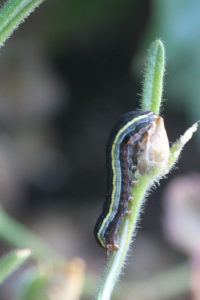Q. I have a worm eating my flowers. The flowers are in a tall planter so I am wondering if I need to add something to the base of the planter to keep them from coming up the plants OR are they hatching out on the plants? Some of the damage is caused by small slugs as well.Can you tell me what kind of worm this is? Also, what do you recommend to deter them? – A.W., Owensville, Indiana
A. Purdue Extension Entomologist Dr. Tim Gibb confirms that this is the yellowstriped armyworm, Spodoptera ornithogalli. If left unchecked, the caterpillars will soon pupate and overwinter in the soil. The pupae hatch into moths in spring/early summer and the females lay eggs on the undersides of leaves. Then the eggs hatch and the developing larvae devour primarily foliage, though late in the season, they may also feed on fruiting vegetables such as tomatoes and peppers.
While there are insecticides that would be effective against this pest earlier in the season, by this late in the summer, the caterpillars are too mature for insecticides to be of much help. Even if it was earlier in the season, for a small planting, frequent inspection combined with handremoval of the pests is the most practical means of control. Pinch off leaves if you notice the eggs attached to the underside. Hand-pick and squish larvae by stepping on them or toss them into a cup of soapy water.
Q. I live on 6 1/2 acres, about a fourth of which is pretty thick woods. I’m clearing (thinning) those woods which are full of baby oak trees and would love to transplant as large as possible specimens to various parts of my property. I’ve had some success with smaller plants, but want larger trees. I have a skid loader (Bobcat) so I can dig a pretty large amount of soil with the transplant, but they do seem to share roots. Consequently, I haven’t much success with larger trees. Any suggestions you might have would be appreciated. – L.M., Wheatfield, Indiana
A. I do not recommend digging trees using a skid loader which will likely damage many trees, the soil, and the local ecosystem. Trees that originate from seeds in the woods often do not transplant well due to having a deep tap root, and to the loss of the fine feeder roots during the move. The older and larger the tree, the less chance for success. There are specially engineered commercial tree spades that can more effectively dig a larger tree and keep the root ball intact during the move, but this machinery is not practical in a woodland.
The smaller, younger saplings about one year old are easier to move with less disruption and likely have the greatest chance for adapting to the new location. Late winter and early spring before the new leaves emerge is generally thought to be the most successful time to transplant.
If you’re wanting larger trees for your landscape, consider purchasing them from a reliable nursery or garden center.
For more information, see Purdue Forestry and Natural Resources publication 433-W, Tree Installation: Process and Practices at https://www.purdue.edu/hla/sites/yardandgarden/wp-content/uploads/sites/2/2017/09/fnr-433-w.pdf.
